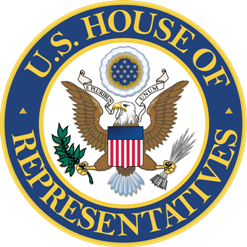The Rise of Single-Party US House Delegations
The number of states (and respective U.S. House seats) with single-party delegations is at its highest level since the mid-1960s
 Following the 2024 election, Smart Politics published a series of reports that highlighted electoral trends signaling the demise of competitive, battleground states such as the 119th Congress setting a record for the lowest number of split U.S. Senate delegations, the number of single-party state congressional delegations reaching a 70+ year high, and the Democratic and Republican parties currently owning record presidential winning streaks in 38 states.
Following the 2024 election, Smart Politics published a series of reports that highlighted electoral trends signaling the demise of competitive, battleground states such as the 119th Congress setting a record for the lowest number of split U.S. Senate delegations, the number of single-party state congressional delegations reaching a 70+ year high, and the Democratic and Republican parties currently owning record presidential winning streaks in 38 states.
With Republicans attempting a mid-cycle redistricting in Texas – and Democrats considering a response in kind in blue states of their own – there has been particular scrutiny on states with seemingly imbalanced partisan delegations in the nation’s lower legislative chamber.
Defenders of the Texas plan have highlighted Massachusetts – a nine-seat state with an all Democratic delegation despite Donald Trump winning 36 percent of the vote. In fact, Massachusetts Democrats have won 146 consecutive U.S. House elections since 1996 and each of the last 45 contests by double digits since 2016 – including a sweep in 2018 when Republican Governor Charlie Baker was reelected at the top of the ticket with 66.6 percent of the vote.
Massachusetts Democrats have now recorded the eighth most consecutive Democratic U.S. House victories in history and the most of any state outside of the South, where there was effective one-party Democratic rule in many states for nearly three-quarters of a century.
But Massachusetts is one of nine states currently in the midst of the longest Democratic or Republican state party winning streak in elections to the chamber along with Connecticut (45 consecutive elections) and Vermont (10) on the Democratic side and Arkansas (28), Wyoming (25), Montana (18), West Virginia (16), Oklahoma (15), and Utah (13) for the Republicans.
After taking into account the nation’s four remaining states with at-large districts (Alaska, Delaware, North Dakota, South Dakota) there are eight additional states with single-party U.S. House delegations in the 119th Congress: Hawaii, Iowa, Idaho, Maine, Nebraska, New Hampshire, New Mexico, and Utah.
That comes to a total of 21 states and 57 seats with single party U.S. House delegations in the current congress – 30 held by the Republicans and 27 for the Democrats. [The 118th Congress had almost identical numbers with only partisan control of Alaska flipping blue to red last November].
The last time as many as 21 or more states had single party U.S. House delegations was during the 88th Congress (1963-1965; 72 seats):
- 9 states were all-Republican: Kansas, Maine, Nebraska, New Hampshire, North Dakota, South Dakota, Utah, Vermont, Wyoming
- 13 states were all-Democratic: Alabama, Alaska, Arkansas, Delaware, Georgia, Hawaii, Idaho, Louisiana, Mississippi, Nevada, New Mexico, Rhode Island, South Carolina
The last time 57 or more seats in the chamber were from states with single-party representation was during the 89th Congress (1965-1967; 69 seats):
- 8 Republican seats: Kansas (5), South Dakota (2), Vermont (1)
- 61 Democratic seats: Alaska (1), Arkansas (4), Colorado (4), Connecticut (6), Delaware (1), Hawaii (2), Louisiana (8), Nevada (1), New Mexico (2), Rhode Island (2), South Carolina* (6), Texas (23), Wyoming (1)
* Note: Until June 1965 when South Carolina U.S. Rep. Albert Watson switched from Democratic to Republican.
The low-water mark during this period took place during the 100th Congress (1987-1989) when just nine states (totaling 15 seats) had single-party delegations (all but three of these were at-large): Alaska, Nebraska, New Hampshire, Vermont, and Wyoming for the GOP and Delaware, North Dakota, South Dakota, and West Virginia for the Democrats.
Looking at apportionment averages by decade, the post-2020 U.S. Census period has had more states with single-party delegations than any of the previous six decades:
- 1963-1972: 18.0 states
- 1973-1982: 13.8 states
- 1983-1992: 10.8 states
- 1993-2002: 15.4 states
- 2003-2012: 14.6 states
- 2013-2022: 18.2 states
- 2023-present: 21.0 states
Likewise, the average number of U.S. House members in single-party delegations is also larger than the last six decades:
- 1963-1972: 54.4 seats
- 1973-1982: 29.0 seats
- 1983-1992: 21.6 seats
- 1993-2002: 34.6 seats
- 2003-2012: 33.0 seats
- 2013-2022: 47.8 seats
- 2023-present: 57.0 seats
During the 2024 cycle, eight states were just one seat away from adding to the list of 21 states with single-party U.S. House delegations: Kansas, Kentucky, Maryland, Mississippi, Nevada, Oregon, South Carolina, and Tennessee.
However, none of the eight respective districts in those states were decided by single digits with the most competitive contest being Democrat Sharice Davids’ 10.8-point victory in Kansas’ 3rd CD.
Follow Smart Politics on X.

[…] trends documenting the decline of competitive, battleground states. Previous reports focused on the rise of single party U.S. House delegations, Democratic and Republican parties currently owning record presidential winning streaks in 38 […]
[…] record presidential winning streaks in 38 states and U.S. Senate winning streaks in 27 states, the rise of single party U.S. House delegations, the 119th Congress setting a record for the lowest number of split U.S. Senate delegations, and […]
[…] is brought up in debate because all nine members of the delegation are Democrats. In fact, a number of states are represented by one party in […]
[…] is brought up in debate because all nine members of the delegation are Democrats. In fact, a number of states are represented by one party in […]